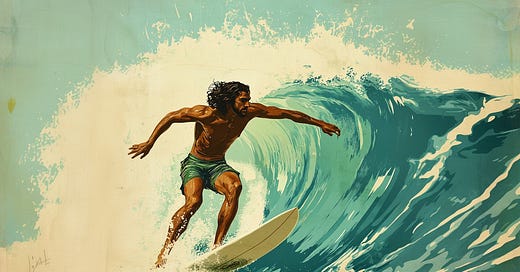One of my first surf instructors was a man by the name of Ishmael; he was paralyzed from the waist down. When Ishmael was younger, he got in a car accident that caused the injury but, through sheer force of will, he was able to regain some mobility in his legs. Enough, at least, to slowly walk from his motorcycle and down to the beach with me each morning.
I don’t believe Ishmael got many students. His style was unorthodox and heavily informed by his inability to use his legs. But I believe these modifications made Ishmael the most effective instructor on the beach.
He taught me something on my 30th birthday that I still think of often.
The waves on that particular day were imposing; mountains of water, slowly rolling towards us, one after another. We started the lesson on the beach, looking way out into the distance—studying the rhythm of the ocean.
He pointed to a man beginning to make his way out. Ishmael told me this man was clearly a beginner, although nothing about that was clear to me. He was in excellent shape, huge shoulders, surfer abs, all the right gear and garb. I would have never suspected, but Ishmael simply said to me, “watch”.
The first job of any surfer is to paddle out beyond the break. This was where all the surfers sit cooly on their boards and chat, before picking the waves they want to ride. Of course, there are obstacles to get beyond the break—namely, the huge, consistent crashing waves.
The man started out. A wave approached, he paddled hard. It pushed him back a few feet. He had lost ground in the swelling ocean wake, but he worked hard to quickly make it back up. Another wave came— again it pushed him back, again he paddled harder. The muscles in his arms, back, and shoulders all fired in unison, cutting through the water with force. Another wave came, and another.
He finally made it out beyond the break. Out there the ocean was calm, but he was breathing heavy.
Ishmael looked at me and said, “We only paddle during the windows. Now watch me.” I did. He slowly limped towards the water, got on his board, and began to paddle. A wave approached. He stopped, and rolled his board under the wave. He made no progress forward, but neither was he pushed backwards. Another wave came, he rolled again. Another, and another and another. Finally, the ocean relented. The water was still; a window formed. His board sat perfectly on top of the surface. He cupped his hands, and in seven effortless strokes, he coasted out beyond the break.
—Zac
PS. If you’ve made it all the way down here and don’t feel that you’ve just wasted five minutes, consider hitting the like button on this essay.
It helps others find it, and it makes me happy!






Great descriptive story!